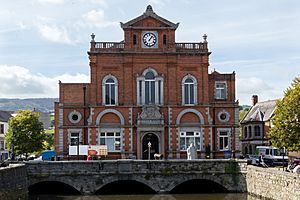Newry Town Hall facts for kids
Quick facts for kids Newry Town Hall |
|
|---|---|

Newry Town Hall
|
|
| Location | Bank Parade, Newry |
| Built | 1894 |
| Architect | William Batt |
| Architectural style(s) | Neoclassical style |
|
Listed Building – Grade B1
|
|
| Official name: Town Hall, Bank Parade, Newry, County Down | |
| Designated | 15 December 1981 |
| Reference no. | HB 16/28/018 B |
| Lua error in Module:Location_map at line 420: attempt to index field 'wikibase' (a nil value). | |
The Newry Town Hall is a special building in Newry, Northern Ireland. It's unique because it was built right on top of a bridge! This bridge crosses the Newry River, which is an old border between County Armagh and County Down. The Town Hall used to be the main office for the Newry Urban District Council. It's also a very important building, listed as a Grade B1 historic site.
Contents
Building the Town Hall
For a long time, the local leaders in Newry met in small offices. But by the late 1800s, they needed a bigger, better place. They decided to build a new town hall on a special spot. This spot was right on the historic border between County Armagh and County Down.
They held a competition to find the best design. An architect named William Batt won. He designed the building in a grand style called Neoclassical. This style often looks like old Greek or Roman temples.
The building was made from red bricks with stone decorations. A local builder, David Mahood, constructed it. The Town Hall officially opened in March 1894. A local leader, the Earl of Kilmorey, helped open it.
A Bridge for the Building
Because of where it was built, the Town Hall needed a strong base. So, a new bridge with three arches was built first. This bridge was designed to hold the heavy building above it.
The front of the building, facing Bank Parade, is very balanced. It has five sections. The middle three sections stick out a little. Here, you can see an arched doorway. It has fancy columns on each side. Above the door, it says "Town Hall."
Higher up, there's a large, open triangle shape called a pediment. Inside it, there's a big, decorative shield with Newry's coat of arms. On the next floor, there's a special window called a Venetian window. It has columns on either side.
At the very top, there's a central gable with a clock. Above the clock, another pediment has a clay panel with the year "1893" written on it. The building also has decorative railings and large pots on the roof. Inside, the most important room was where the local council met.
Town Hall Through the Years
In 1899, Newry became an "urban district." This meant it had its own local government, and the Town Hall became its main office.
Over the years, some interesting things were added outside. In 1938, a Russian cannon was moved to the front of the Town Hall. This cannon was from a war called the Crimean War. A year later, in 1939, a war memorial was placed nearby.
The Town Hall was the center of local government for many years. But in 1973, a bigger council, the Newry and Mourne District Council, was formed. They moved to new offices, so the Town Hall was no longer the main government building.
A Place for Events
Even after the council moved out, the Town Hall remained a busy place. It became a popular spot for events and performances. For example, the famous rock band U2 played there in February 1980.
In 2004, a large stone monument was placed outside. It celebrates Terence Bannon, a mountaineer from Northern Ireland. He was the second person from Northern Ireland to reach the top of Mount Everest. The mayor of Newry, Councillor Jack Patterson, helped unveil it.
The building got some important updates in January 2018. These improvements made it even better for theatre shows and concerts.
Inside the Town Hall, you can also find art. There's a statue of Lord Russell of Killowen. He was a very important judge in England and was born in Newry.

